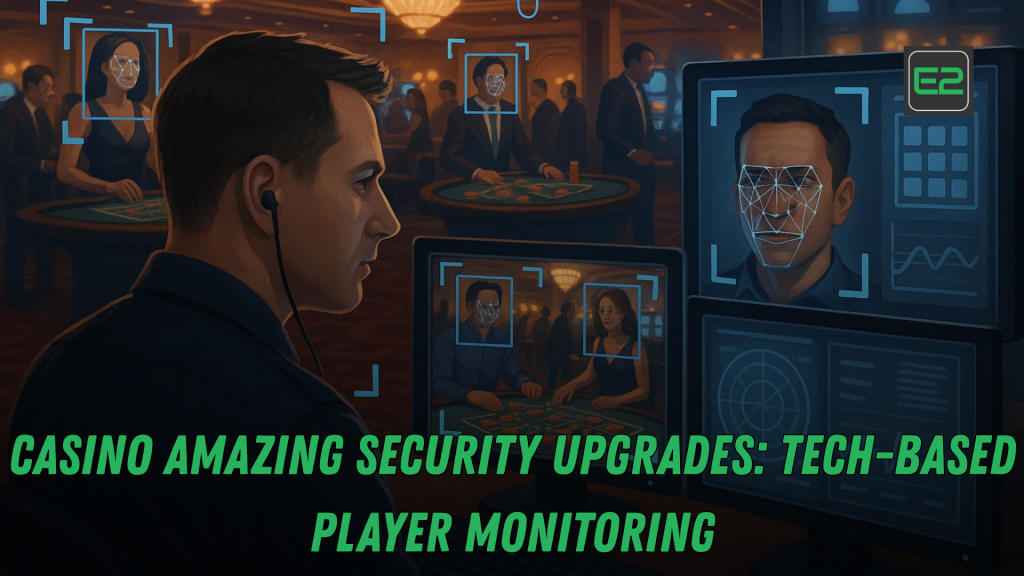Table of Contents
Executive Summary
Casinos are transforming from camera-heavy fortresses into data-driven risk centers. The next edge isn’t just more pixels—it’s clean telemetry, real-time analytics, and disciplined operations that link the pit, cage, loyalty, compliance, and the SOC (security operations center). This guide breaks down the modern stack of tech-based player monitoring, shows how to integrate tools without violating guest trust, and gives you a rollout roadmap with measurable ROI. If your property (or online brand) is upgrading surveillance, AML, or responsible-gaming capabilities in 2025, this is your blueprint.

Why Casinos Upgrade Now: The Forces Reshaping Casino Security
- Converging threats: advantage play, collusion, chip/cash theft, account takeovers, bonus abuse, synthetic IDs, mule accounts, and payment fraud.
- Regulatory pressure: tighter expectations for AML/KYC, source-of-funds checks, PEP/sanctions screening, and transaction monitoring across cash cages, cage-less wallets, and cross-channel play.
- Cashless & omnichannel: e-wallets, TITO, and iGaming extensions produce new telemetry—and new attack surfaces.
- Guest expectations: patrons want friction-light safety, discreet interventions, and transparency about data use.
- Talent constraints: fewer seasoned surveillance pros; your solution must be explainable and trainable.
Bottom line: Do more with the data you already have, then layer in smarter sensors where they truly move risk.
The Modern Casino Monitoring Stack: From Sensor to Action
Think in lanes. Each lane feeds clean, timestamped data to analytics and case management, then to human decision.
1) Vision & Venue Layer (Physical)
- AI video analytics: object/person detection, dwell/time-on-device, suspicious handoffs, unattended value items, queue anomalies.
- Facial recognition (policy-bound): used only where lawful and with clear governance (VIP recognition, self-exclusion enforcement, trespass watch lists).
- LPR & access control: license-plate recognition for parking audit trails; carded access with anti-passback for sensitive zones.
- RFID & smart tables: tagged chips, card shoes with shuffle logs, and auto-rating that reconciles with loyalty and pit notes.
- Slot floor sensors: cabinet door events, hopper/stack telemetry, door-open correlation with attendant presence.
2) Gameplay & Cashflow Layer
- Player-tracking systems (PTS): buy-ins, average bet, theoretical win (theo), hands played, time-on-device.
- Cashless telemetry: wallet loads/unloads, payment instrument tokens, device reputation, and velocity limits.
- Cage & TITO: redemption patterns, jackpot validations, SAR/CTR thresholds (where applicable), unusual structuring.
- Loyalty & offers: comp burn patterns; mismatch between theo and comp value that can signal over-rating or manipulation.
3) Identity & Device Layer (On-prem + Online)
- KYC/IDV: document verification, liveness checks, risk scoring.
- Device fingerprinting: browser/app signals, emulator detection, IP reputation, geo-fencing and geo-compliance.
- Account graphing: shared devices, addresses, payments—detects multi-accounting and collusion rings.
- Authentication hygiene: MFA adoption, impossible-travel checks, session risk scoring.
4) Analytics & Operations Layer
- SIEM & UEBA: centralize logs and create behavioral baselines; alert on deviations (e.g., sudden late-night redemptions, pit override spikes).
- SOAR: automated playbooks for tiered responses (freeze wallet, pause comping, ping supervisor, escalate to surveillance).
- Case management: link alerts, video, receipts, table logs, and staff notes; support chain of custody and disclosure.
High-Value Casino Use Cases (What Actually Reduces Risk)
- Self-exclusion & barred individuals: Face match + loyalty + door cams to prevent entry or notify guest services for discreet handling.
- Advantage play signals: chronic back-counting, abnormal spread patterns, team signaling, or rating anomalies that over-credit theo.
- Chip/cash diversion: watch for unusual chip color flows, cashier discrepancies, and box/marker mismatches correlated with staff schedules.
- Account takeovers (ATO) in iGaming: sudden device change + failed MFA + new payment token + high-velocity withdrawals.
- Bonus abuse rings: multiple accounts sharing identity artifacts, synchronous play behaviors, staged losses/transfers.
- Source-of-funds concerns: large cash buy-ins from high-risk profiles without plausible income signals; structured transactions just under reportable thresholds.
- Responsible-gaming patterning: extreme time-on-device, escalating deposits after losses, ignored cooling-offs, midnight-to-dawn streaks. The response is supportive—not punitive.
Responsible Casino Gaming Analytics: Safety Without Stigma
The best programs detect and defuse harm early:
- Signals: deposit escalations, chasing behavior, rejected payment attempts, playing through wins, session chaining without breaks.
- Interventions: nudges (“You’ve played 2 hours; consider a break”), voluntary limits, cooling-off offers, self-assessment tools, and trained human outreach.
- Tone matters: messaging should be empathetic, not accusatory. Log the context, outcomes, and next steps.
- Guardrails: no cross-selling during RG interventions; honor self-exclusion with tech and staff awareness.
Casino Privacy-by-Design: How to Win Trust While Monitoring
- Data minimization: collect what you need for safety/compliance, not everything “just in case.”
- Purpose limitation: clearly define allowed uses (e.g., self-exclusion enforcement, AML, venue safety).
- Access control: role-based, least privilege; every sensitive search is auditable.
- Retention schedules: differentiate patrol (short), incidents (longer), compliance archives (regulated).
- In-venue transparency: signage that explains surveillance and self-exclusion enforcement; clear contact point for privacy requests.
- Vendor diligence: DPAs, sub-processor lists, breach reporting windows, and model risk documentation for AI tools.
- Human-in-the-loop: no sole reliance on automated decisions for consequential outcomes.
Building Your SOC for Casino Gaming: People, Process, Platforms
- People: cross-train surveillance, compliance, and IT security. Assign use-case owners (e.g., RG, AML, Fraud, Safety).
- Process: playbooks per alert type, escalation ladders, 24/7 coverage for critical tiers.
- Platforms: SIEM for telemetry; UEBA for behavior; SOAR for automation; case management for investigations.
- Quality: false-positive review loops; monthly model calibrations; quarterly tabletop exercises.
- Metrics: response time, case cycle time, loss avoided, voluntary RG opt-ins, repeat incidents down.
Casino Implementation Roadmap: 30 / 60 / 90 / 180 Days
Days 0–30: Foundation
- Map data sources (video, PTS, cage, wallets, access control, online platform).
- Quick wins: strengthen MFA, device reputation, and geo-fencing for online; fix camera blind spots on the pit and cage.
- Draft privacy & AI usage policy; update signage templates.
Days 31–60: Integrations
- Connect PTS + cage + access control to SIEM; stand up RG signal dashboard.
- Pilot AI video analytics on 1–2 high-risk zones; tune alerts with supervisors.
- Launch SOAR playbooks for common fraud/RG scenarios.
Days 61–90: Scale & Train
- Expand analytics to slots and table games; integrate RFID chips or smart shoes if available.
- Train staff on intervention scripts (RG), evidence handling (case mgmt), and playbook drills.
- Start weekly cross-functional standups (Surveillance × Compliance × IT Sec × Operations).
Days 91–180: Optimize & Measure
- Add advanced identity (doc+biometric) at high-risk edges; ramp account graphing in iGaming.
- Calibrate KPIs: reduction in loss events, ATOs, chargebacks, and high-risk RG episodes; time-to-intervention improves.
- Audit trail review; refresh vendor SLAs; publish privacy FAQs on your site.

Capturing ROI: Make the Numbers Work
- Loss events avoided: average incident cost × incidents prevented.
- Labor efficiency: analyst hours saved via SOAR × hourly rate.
- Chargeback reduction: iGaming and cashless flow improvements.
- Compliance risk: estimate avoided fines/consent orders by closing gaps.
- Guest lifetime value: safer venue + fair play = improved loyalty and word-of-mouth.
Position upgrades not as costs, but as risk-adjusted margin improvements.
Casino Advanced Topics (When You’re Ready)
- Table vision: overhead multi-camera modeling to reconstruct hands, chip moves, and covert exchanges.
- Explainable AI: feature attribution for alerts (why this wager pattern?) to support investigation notes and audits.
- Federated learning: share model insights across properties without centralizing raw patron data.
- Real-time comp sanity: auto-flag comp values that exceed theoretical by a defined multiple.
- Threat hunting: purple-team your wallet flows and cage workflows; find paths to abuse before attackers do.
Common Casino Pitfalls—and How to Avoid Them
- Tech without playbooks: fancy dashboards that nobody uses under pressure. Fix: write clear SOPs and drill them.
- Alert fatigue: too many noisy rules → everything gets ignored. Fix: tiering, weekly pruning, and genuine post-mortems.
- Privacy blowback: surprise use of facial recognition. Fix: explicit notices, opt-outs where possible, and solid policy.
- One-way training: compliance lectures without role-play. Fix: scenario-based training with supervisors and guest services.
- Siloed data: pit knows, cage knows, loyalty knows—but nobody sees the whole picture. Fix: integrate to case management.
Communications: How to Talk to Casino Guests and Staff
- Guests: “We prioritize fair play and safety. Some technologies help us enforce self-exclusion and protect your accounts. Learn more at [privacy desk].”
- Staff: “Tools support your judgment. If it isn’t in the playbook, escalate. When in doubt, document.”
- Regulators & partners: share your governance artifacts—retention, access controls, model testing, and incident post-mortems.
Checklist: Tech-Based Player Monitoring Essentials
- Camera coverage audited; high-risk zones hardened.
- SIEM receiving PTS, cage, access, wallet, and online telemetry.
- UEBA baselines built; KPIs defined.
- SOAR playbooks for RG, AML, fraud, safety.
- Case management with chain of custody.
- Privacy policy + signage + DSR (data subject request) workflow.
- Staff training (RG scripts, evidence, de-escalation).
- Quarterly model calibration & tabletop exercises.
Call to Action
Ready to modernize without alienating guests? Start with a 30-day foundation sprint: fix blind spots, unify telemetry, publish your privacy stance, and pilot one high-value use case (e.g., self-exclusion enforcement or ATO prevention). From there, scale analytics and automate only where you’ve proven the signal. If you want a tailored rollout plan—tech shortlist, SOPs, training decks, and KPIs—reach out. We’ll help you go from cameras to clarity.
Final Word
The guide positions modern casinos as data-driven risk centers rather than camera-saturated fortresses. Competitive advantage now comes from clean telemetry, real-time analytics, and disciplined operations that connect surveillance, pit/cage, loyalty, compliance, and a security operations center (SOC). Upgrading in 2025 is urgent due to converging threats (advantage play, collusion, chip/cash diversion, account takeovers, bonus abuse, synthetic IDs), tighter AML/KYC expectations, the rise of cashless/omnichannel play (e-wallets, TITO, iGaming), guest demand for discreet safety, and talent shortages that require explainable, trainable tools.
The Casino Modern Monitoring Stack
The stack is organized in lanes that feed timestamped data into analytics and case management:
- Vision & Venue (Physical):
- AI video analytics for objects/people, dwell time, handoffs, unattended items, queue anomalies.
- Facial recognition only where lawful and policy-bounded (self-exclusion, trespass, VIP).
- Access control & LPR for sensitive zones and parking trails.
- RFID & smart tables for chip tagging, shuffle logs, and auto-rating that reconciles with loyalty data.
- Slot sensors for cabinet events and correlation with attendant actions.
- Gameplay & Cashflow:
- Player tracking systems (PTS): buy-ins, average bet, theo, time-on-device.
- Cashless telemetry: wallet loads/withdrawals, device reputation, velocity limits.
- Cage/TITO: redemption patterns, jackpot validation, structuring alerts.
- Loyalty/offers: comp burn vs. theo mismatches that may signal manipulation.
- Identity & Device (On-prem + Online):
- KYC/IDV with document + liveness.
- Device fingerprinting, IP reputation, geo-fencing.
- Account graphing (shared devices/addresses/payments) to spot multi-accounting and rings.
- Authentication hygiene: MFA, impossible travel, session risk scoring.
- Analytics & Operations:
- SIEM & UEBA centralize logs, build behavioral baselines, and alert on deviations.
- SOAR automates tiered responses (freeze wallet, pause comps, ping supervisor).
- Case management links alerts, video, logs, receipts, and staff notes with chain-of-custody.
High-Value Use Cases
- Self-exclusion/barred enforcement with face match and loyalty checks.
- Advantage play detection via spread patterns, team signaling, or over-rating anomalies.
- Chip/cash diversion through unusual chip flows and cashier discrepancies.
- Account takeovers: device change + failed MFA + new payment token + high-velocity withdrawals.
- Bonus abuse rings: shared identity artifacts and synchronized play.
- Source-of-funds concerns: large cash buy-ins from high-risk profiles; structured thresholds.
- Responsible gaming (RG): escalating deposits, session chaining, overnight play—triggering supportive, not punitive, interventions (nudges, limits, cooling-off, human outreach).
Privacy-by-Design
Trust comes from data minimization, purpose limitation, role-based access, auditable searches, sensible retention, in-venue transparency (signage, contact point), vendor diligence (DPAs, sub-processors, breach windows), and human-in-the-loop decisions. Facial recognition must be governed, disclosed, and limited to approved uses.
Building the Gaming SOC
Cross-train surveillance, compliance, and IT security; assign use-case owners (RG, AML, fraud, safety). Implement clear playbooks, escalation ladders, 24/7 coverage for critical tiers, and platforms for SIEM/UEBA/SOAR/case management. Maintain quality with false-positive reviews, model calibration, tabletop exercises, and KPIs like response time, case cycle time, loss avoided, RG opt-ins, and repeat-incident reduction.
30/60/90/180-Day Roadmap
- 0–30 days: Map data sources; fix camera blind spots; strengthen MFA, device reputation, geofencing; publish privacy/AI usage stance.
- 31–60 days: Integrate PTS + cage + access control into SIEM; launch an RG dashboard; pilot AI analytics in high-risk zones; deploy first SOAR playbooks.
- 61–90 days: Scale to slots/tables; train staff on RG scripts and evidence handling; start weekly cross-functional standups.
- 91–180 days: Add advanced IDV and account graphing; refine KPIs (loss events avoided, ATO decline, time-to-intervention); audit trails; refresh vendor SLAs; publish privacy FAQs.
ROI Framing
Treat upgrades as risk-adjusted margin improvements, not sunk costs: quantify loss events avoided, labor efficiency from automation, chargeback reductions, avoided fines, and uplift in guest lifetime value from safer, fairer play.
Advanced Options
Table-vision reconstructions, explainable AI for audit-ready alerts, federated learning across properties, real-time comp sanity checks, and proactive threat hunting for cage/wallet workflows increase maturity once basics are stable.
Common Pitfalls
Avoid tech without playbooks, alert fatigue, privacy surprises, lecture-only training, and siloed data. Fix with SOPs, alert tiering and pruning, transparent signage/policies, scenario role-play, and unified case management.
Communications & Checklist
Guests: emphasize fair play and safety with clear privacy info. Staff: tools support judgment; escalate when uncertain; document everything. Regulators: share governance artifacts. The checklist covers camera audits, integrated telemetry, UEBA baselines, SOAR playbooks, case management with chain of custody, privacy workflows, staff training, and quarterly model/tabletop cycles.

Call to Action & FAQs
Start with a 30-day foundation sprint: unify data, fix blind spots, publish policies, and pilot one high-value use case (e.g., self-exclusion enforcement or ATO prevention). FAQs clarify that facial recognition isn’t mandatory, AML can be risk-based with minimal friction, cashless controls hinge on MFA/velocity/geo checks, success should be measured beyond “no incidents,” and the best first project is data unification + a focused pilot.
Overall, the winners connect dots ethically, transparently, and fast, ensuring every alert drives a safer floor, stronger compliance, and better guest stories.
Frequently Asked Questions (FAQ)
1) Is facial recognition necessary for modern casino security?
Not always. It can help with self-exclusion, trespass enforcement, and VIP service—but only where it’s lawful, clearly disclosed, and policy-bounded with audit trails. Many properties get strong risk reduction using AI video analytics, RFID chips, and integrated case management without universal face match.
2) How do we balance AML monitoring with guest experience?
Use tiered, risk-based thresholds and automate back-office checks (transaction clustering, velocity, sanctions re-screens). Keep frontline interventions polite and brief, and move complex questions to compliance desks. Transparency (“Why we’re asking”) reduces friction.
3) We’re moving to cashless. What are the top controls?
Require MFA and device reputation for wallet logins, set velocity caps and cool-offs for loads/withdrawals, monitor geo-fencing, and verify source-of-funds on escalations. Pair with SOAR playbooks to freeze wallets and notify guests fast during suspected ATOs.
4) How do we measure success beyond ‘no incidents’?
Track loss events avoided, time-to-intervention, false-positive rate, repeat incident reduction, chargeback decline, and RG metrics like voluntary limit adoption. Combine with staff surveys on alert quality and guest feedback on perceived safety.
5) What’s the best first project if budgets are tight?
Unify existing data (PTS, cage, access) into case management and SIEM. Pilot one AI camera zone (pit or cage) and one fraud/RG playbook in SOAR. You’ll see immediate gains in visibility and response without a full rebuild—and you’ll learn where the ROI truly is.
